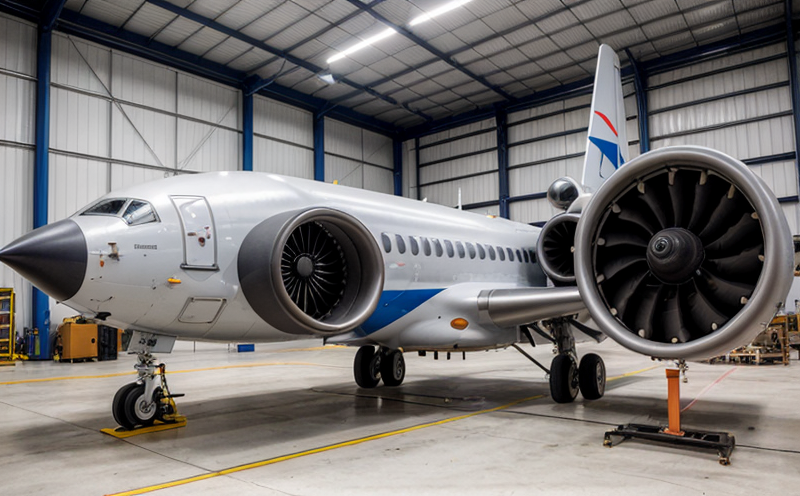Propeller-Induced Vibration Testing
The aerospace and defense industry places a significant emphasis on ensuring that all components operate reliably under the most challenging conditions. Propeller-induced vibration testing is critical in this context as it evaluates how aircraft propellers and related systems perform when subjected to dynamic loading, which can occur during takeoff, landing, and cruise operations.
During flight, propellers generate significant vibrations due to aerodynamic forces, engine power, and the interaction with the airframe. These vibrations are not only a source of potential damage but also influence passenger comfort and overall structural integrity. Propeller-induced vibration testing aims to identify any issues that could arise from these conditions before they manifest as failures in operational environments.
One key aspect of this test is understanding the complex interaction between the propeller blades, engine, and airframe. The goal is to ensure that all components are designed with appropriate damping mechanisms to mitigate harmful vibrations. This involves analyzing not just the static performance but also the dynamic behavior under various loading conditions. Testing in this domain often follows international standards such as ISO 16724 for aerospace structures.
The testing process typically includes detailed specimen preparation, where engineers replicate realistic operational scenarios using test rigs that mimic flight dynamics. This allows for a comprehensive evaluation of how different variables—such as speed, altitude, and engine power—affect the propeller’s performance and vibration output. The use of advanced instrumentation provides precise measurements of acceleration, displacement, and strain across various frequencies.
From a structural integrity perspective, this testing ensures that components are not only capable of withstanding high-stress environments but also maintain their operational efficiency over time. By identifying potential weak points early in the design phase, engineers can refine materials and manufacturing processes to enhance durability and reliability. This is particularly important for aerospace applications where safety and performance are paramount.
The results from propeller-induced vibration testing play a crucial role in certification processes by providing data that supports compliance with regulatory requirements. For instance, tests conducted according to ASTM standards help ensure that products meet specific criteria for structural integrity and operational reliability. The insights gained from these tests also contribute to ongoing research aimed at improving aircraft design and performance.
In conclusion, propeller-induced vibration testing is an essential component of the aerospace industry's quality assurance process. It ensures that critical components like propellers are robust enough to handle real-world conditions while maintaining optimal performance levels. This approach not only enhances safety but also contributes to more efficient and sustainable flight operations.
Why Choose This Test
- Identifies potential issues early in the design phase, ensuring robust components that can handle real-world conditions.
- Supports compliance with international standards such as ISO 16724 and ASTM, which are crucial for certification processes.
- Mimics realistic operational scenarios using advanced test rigs to provide comprehensive evaluation of propeller performance under various loading conditions.
- Aids in optimizing design parameters to enhance safety, durability, and overall efficiency.
- Provides critical data that contributes to ongoing research aimed at improving aircraft design and performance.
- Ensures that components meet specific criteria for structural integrity and operational reliability, supporting certification processes.
- Reduces maintenance needs by identifying potential weak points in propeller design early on, leading to more efficient flight operations with reduced environmental impact.
International Acceptance and Recognition
The international community widely accepts and recognizes the importance of propeller-induced vibration testing. Compliance with recognized standards such as ISO 16724 and ASTM is essential for ensuring that aerospace components meet stringent quality assurance criteria. These standards provide a benchmark for consistent performance across different manufacturers, fostering trust within the industry.
Aerospace companies around the world rely on rigorous testing protocols to ensure their products are safe and reliable. By adhering to these internationally accepted guidelines, companies can demonstrate their commitment to maintaining high-quality standards. This not only enhances reputation but also opens doors for global markets by meeting regulatory requirements in various countries.
The use of standardized testing procedures ensures that all participants follow the same protocol when evaluating propeller performance. This consistency allows for better comparisons between different products and helps identify best practices within the industry. As a result, aerospace organizations can collaborate more effectively on research projects and development initiatives aimed at advancing technology in this field.
In conclusion, international acceptance and recognition of propeller-induced vibration testing underscore its significance in ensuring safety, reliability, and compliance with global standards. By embracing these practices, manufacturers contribute to the advancement of aviation technology while maintaining a strong focus on quality assurance.
Environmental and Sustainability Contributions
The environmental impact of aerospace operations is a growing concern, and propeller-induced vibration testing plays an integral role in addressing this issue. By ensuring that components are designed with durability in mind from the outset, manufacturers can minimize the need for frequent maintenance and replacements. This reduces waste associated with discarded parts while extending product lifecycles.
Furthermore, optimizing design parameters through rigorous testing helps reduce fuel consumption during flight operations. Efficient engines and well-engineered propellers contribute to lower emissions per passenger mile traveled, thus promoting greener travel options. The aerospace industry has made significant strides towards sustainability by adopting eco-friendly practices such as using lighter materials that require less energy for transport.
Testing also facilitates the development of quieter propulsion systems which reduce noise pollution in communities near airports. Quieter engines and propellers lead to improved air quality around these areas, making flying more acceptable for local residents. In addition, advancements made through testing can extend the useful life of aircraft fleets, reducing the need for new production runs which consume valuable resources.
In summary, propeller-induced vibration testing contributes significantly to environmental sustainability efforts in several ways. From extending product lifecycles and minimizing waste to fostering quieter engines and promoting longer-lasting aircraft fleets, this process supports a more sustainable approach to air travel.





